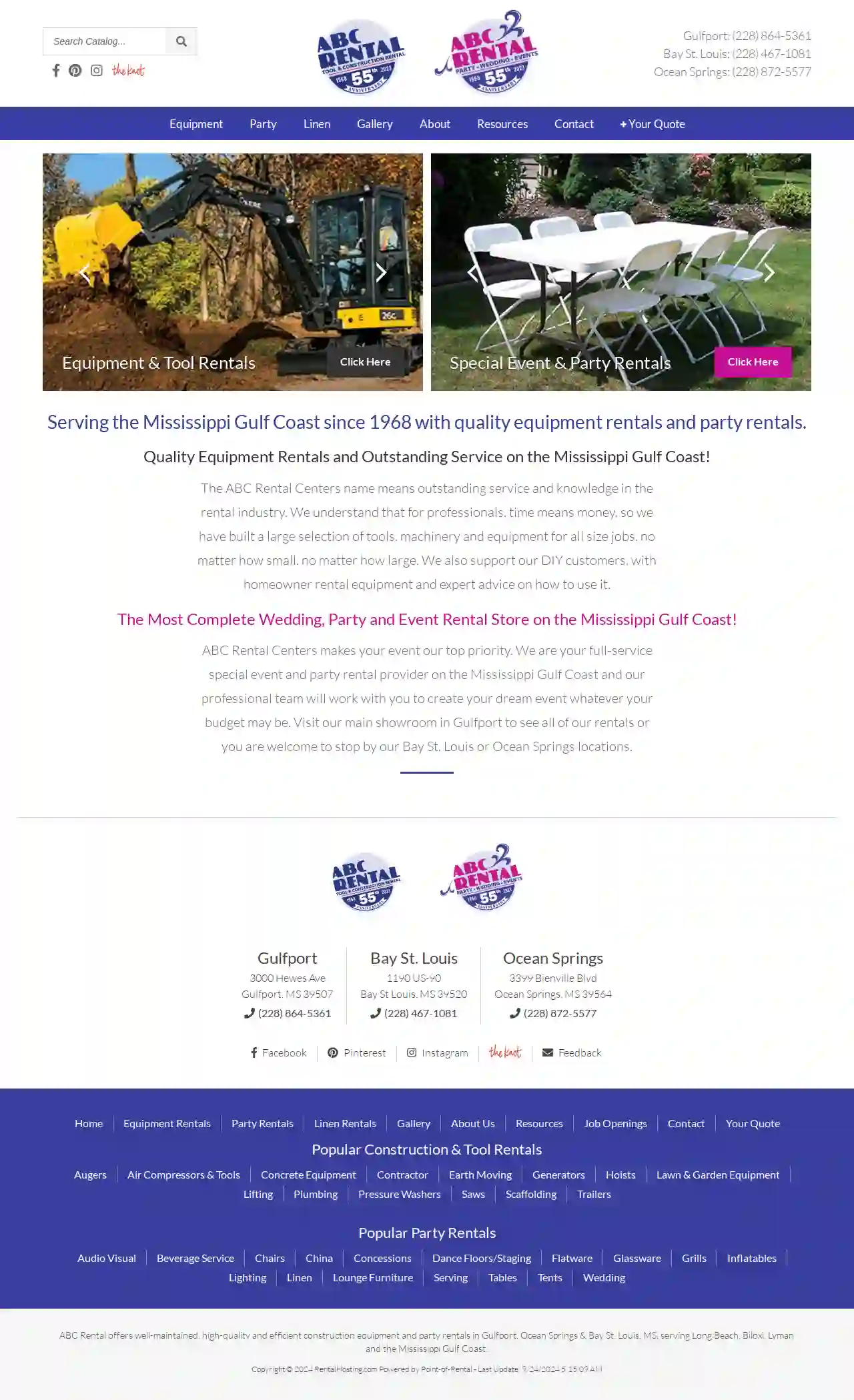Scaffolding Companies St. Martin
Top 10 Scaffolding Companies in St. Martin
Receive multiple Scaffolding Erectors quotes for your project today! Compare profiles, reviews, accreditations, portfolio, etc... and choose the best offer.
Service Needed
City or Town

ABC Rental Center
4.4151 reviews3000 Hewes Ave, Gulfport, 39507, USABC Rental offers well-maintained, high-quality and efficient construction equipment and party rentals in Gulfport, Ocean Springs & Bay St. Louis, MS, serving Long Beach, Biloxi, Lyman and the Mississippi Gulf Coast. With a wide range of equipment and party rentals, ABC Rental is dedicated to providing outstanding service and knowledge in the rental industry.
- Services
- Why Us?
- Gallery
Get Quote- Ma
Magnolia Masonry of South Mississippi LLC
4.914 reviewsGulfport, US- Services
- Why Us?
Get Quote - Cr
Crom Equipment Rentals Inc
Gulfport, US- Services
- Why Us?
Get Quote - Th
The Home Depot
4.2Gulfport, US- Services
- Why Us?
Get Quote - Lo
Lowe's Home Improvement
4.1Gulfport, US- Services
- Why Us?
Get Quote
Over 2,353+ Scaffolding Contractors on our platform
Our scaffolding contractors operate in St. Martin and surrounding areas!
ScaffoldingHQ has curated and vetted the Best Scaffolding Companies near St. Martin. Find a top & reliable business today.
Frequently Asked Questions About Scaffolding Companies
Find answers to common questions about scaffolding companies and hiring scaffolding contractors in the USA.
- A larger, more complex structure typically used for accessing multiple levels of a building.
- Offers greater height and versatility.
- Often used for construction, renovation, and maintenance.
- Smaller, portable platforms usually used for tasks at a single level.
- Commonly used for painting, plastering, or light repairs.
- Can be rolling or stationary.
- Licensing and Insurance: Verify their licenses are current and that they have adequate insurance coverage.
- Experience: Choose a company with a history of successfully completing similar projects. Ask for references and check their portfolio.
- Safety Record: Inquire about their safety practices and accident history. A strong safety culture is essential.
- Professionalism: Observe their communication, responsiveness, and attention to detail. A reputable company will be organized and transparent.
- Reviews and Testimonials: Read online reviews and feedback from previous clients to assess their reputation.
- Industry Affiliations: Membership in professional organizations like the NASC (National Access & Scaffolding Confederation) indicates a commitment to industry standards.
Can I erect scaffolding myself?
While it might seem tempting to save money, it's strongly recommended NOT to erect scaffolding yourself unless you are a trained and competent scaffolding erector. Scaffolding erection requires specialized knowledge, skills, and tools to ensure safety and structural stability. Incorrectly erected scaffolding can lead to serious accidents. Always hire a qualified and experienced scaffolding company to handle the installation and dismantling of scaffolding.
What is the difference between scaffolding and staging?
While both provide elevated work platforms, they differ in scale and purpose:
Scaffolding:
Scaffolding:
How do I know if a scaffolding company is reputable?
Look for these indicators of a reputable scaffolding company:
What is a scaffolding hoist?
A scaffolding hoist is a mechanical device used to lift materials and equipment vertically up and down scaffolding. It's essential for larger projects where manually carrying heavy items up multiple levels is impractical and unsafe. Scaffolding hoists come in various types and capacities, and their selection depends on the weight and size of the materials being lifted.
Can I erect scaffolding myself?
While it might seem tempting to save money, it's strongly recommended NOT to erect scaffolding yourself unless you are a trained and competent scaffolding erector. Scaffolding erection requires specialized knowledge, skills, and tools to ensure safety and structural stability. Incorrectly erected scaffolding can lead to serious accidents. Always hire a qualified and experienced scaffolding company to handle the installation and dismantling of scaffolding.
What is the difference between scaffolding and staging?
While both provide elevated work platforms, they differ in scale and purpose:
Scaffolding:
Scaffolding:
- A larger, more complex structure typically used for accessing multiple levels of a building.
- Offers greater height and versatility.
- Often used for construction, renovation, and maintenance.
- Smaller, portable platforms usually used for tasks at a single level.
- Commonly used for painting, plastering, or light repairs.
- Can be rolling or stationary.
How do I know if a scaffolding company is reputable?
Look for these indicators of a reputable scaffolding company:
- Licensing and Insurance: Verify their licenses are current and that they have adequate insurance coverage.
- Experience: Choose a company with a history of successfully completing similar projects. Ask for references and check their portfolio.
- Safety Record: Inquire about their safety practices and accident history. A strong safety culture is essential.
- Professionalism: Observe their communication, responsiveness, and attention to detail. A reputable company will be organized and transparent.
- Reviews and Testimonials: Read online reviews and feedback from previous clients to assess their reputation.
- Industry Affiliations: Membership in professional organizations like the NASC (National Access & Scaffolding Confederation) indicates a commitment to industry standards.
What is a scaffolding hoist?
A scaffolding hoist is a mechanical device used to lift materials and equipment vertically up and down scaffolding. It's essential for larger projects where manually carrying heavy items up multiple levels is impractical and unsafe. Scaffolding hoists come in various types and capacities, and their selection depends on the weight and size of the materials being lifted.